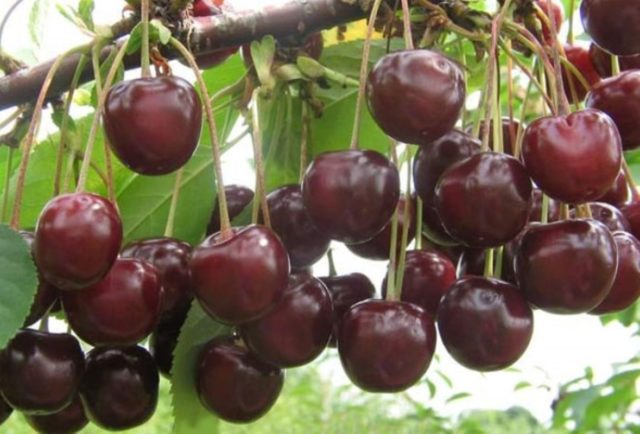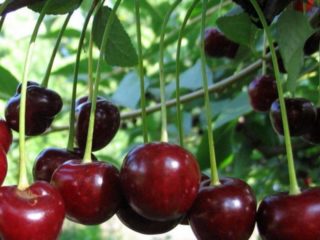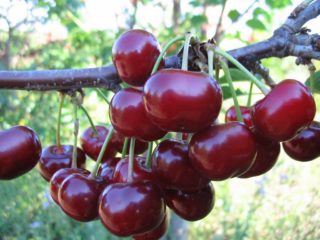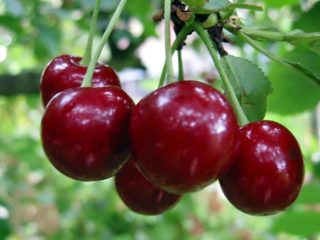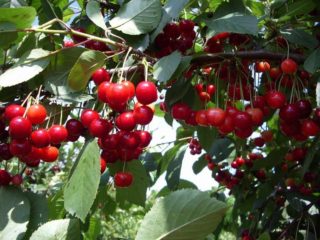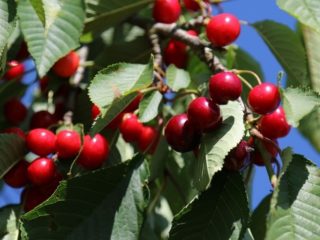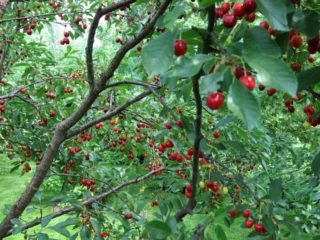Content
Cherry Nord Star, or Star of the North, is a popular hybrid of American breeding. It was bred in 1950 by an unknown breeder in the state of Minnesota by interspecific crosses. The parents of the variety are the Western European variety of cherry Lotovaya and a seedling grown from a cherry seed of a tree of unknown origin.
Description of Nord Star cherries
Cherry Nord star is a short, compact tree. The crown is rather thick and wide, round in shape. The color of the bark of the trunk and branches is dark brown. Leaves are narrow oval, small, shiny. Cherry variety Nord Star is adapted for cultivation in southern latitudes and central Russia.
Height and dimensions of an adult tree
The tree grows most actively at a young age. From the moment it enters the fruiting stage, it becomes moderate. The height of Nord Star cherries at the age of ten is 2, -2.5 m.
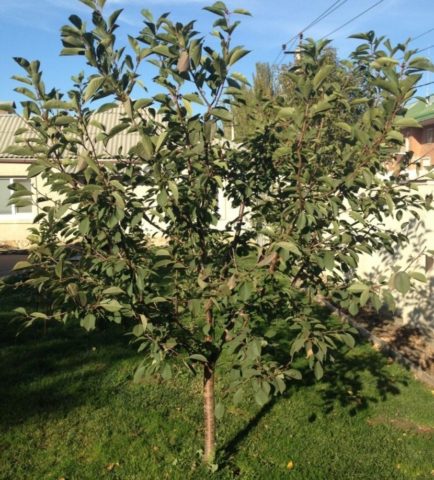
Young tree Nord Star
Description of fruits
The main characteristics of the cherry fruits of the Nord Star variety:
- berry weight - 4-4.5 g;
- shape - round or wide-round;
- the skin is thin, shiny;
- color - dark red;
- the pulp is reddish, delicate, fibrous, juicy;
- taste - sweetish-sour, more sour;
- the stone is round, of medium size.
Cherry tasting score - 3.8-4 points. The separation from the peduncle is dry. The pulp is easily separated from the stone. When ripe, the berries do not crumble, they do not bake in the sun. The density of the fruits is low, therefore, they do not differ in good keeping quality and transportability.
Cherry pollinators Nord Star
Cherry Nord Star (Star of the North) is a partially self-fertile variety, therefore, the highest productivity is observed in collective plantings. Cherries such as Oblachinskaya, Nefris, Meteor are ideal as pollinators. In terms of flowering time, the tree is medium-flowering. Flowering begins in May.
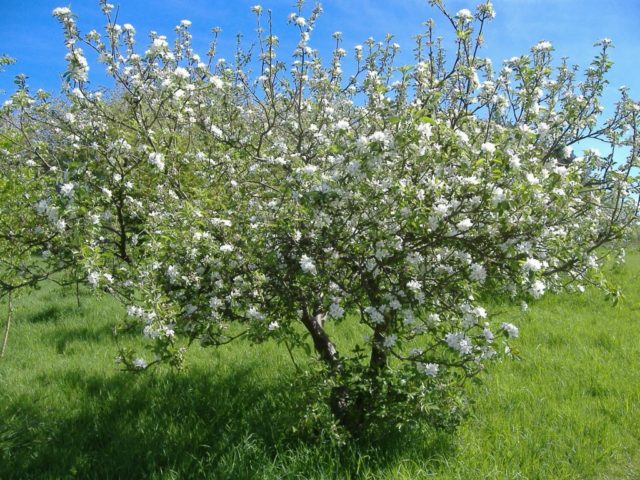
Spring cherry blossoms look very beautiful
Main characteristics of Nord Star cherries
To get acquainted with the Nord Star cherry in detail, it is necessary to study the main distinctive characteristics of the tree and the taste of the fruit.
Drought resistance, frost resistance
The variety is drought-resistant, therefore it easily tolerates prolonged sultry heat in summer. Differs in high frost resistance. Belongs to the 5th zone of winter hardiness, withstands frosts up to 32-40 ° C.
Yield
The fruiting period in grafted trees begins 2-3 years after planting. The maximum fertility is observed from 4-5 years of age.The highest yields are possible when growing trees in joint plantings with other varieties of cherry. Average yield is 15-25 kg from 1 adult tree.
The variety is considered late-ripening. The berries begin to ripen in July-August. The fruiting pattern of Nord Star cherries is mixed. The main crop is formed on 1-3-year-old branches. Fruits for universal purposes - suitable for fresh consumption and for processing. But most often they are processed - canned compotes, jams, make dried fruits. Also, the fruits, flowers and leaves of the Nord Star cherry can be used in folk medicine.
Advantages and disadvantages
Like other varieties of cherries, Nord Star has certain advantages and disadvantages.
North Star benefits:
- high dessert quality of fruits;
- small size of the tree;
- early maturity;
- high and stable yields;
- suitability for thickened planting (the distance between trees can be 2 m);
- high degree of self-fertility;
- drought resistance;
- winter hardiness;
- not afraid of recurrent frosts due to late flowering;
- immunity to clasterosporia and coccomycosis.
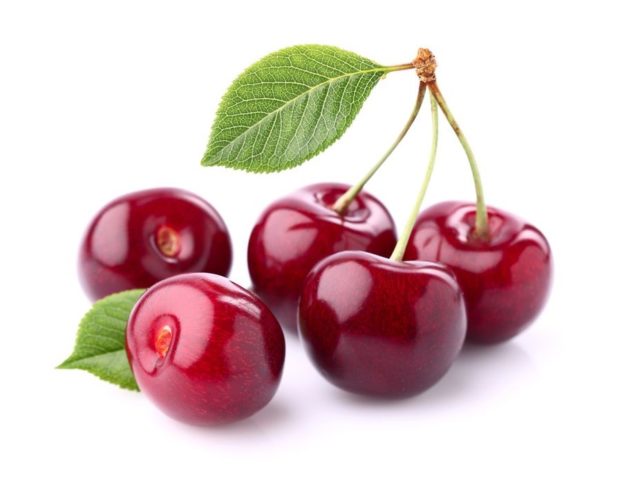
Ripe fruits are easily separated from the stalk, the separation is dry
Disadvantages of the variety:
- increased acidity of the fruit;
- susceptibility to moniliosis.
Landing rules
In general, the process of planting Nord Star cherries does not have its own peculiarities and practically does not differ from other varieties of cherries. The main thing is to choose the right place for planting a tree, taking into account its varietal characteristics.
Recommended timing
You can root Nord Star cherry seedlings both in spring and autumn. The timing will depend on the climatic characteristics of the region. In temperate climates, mid-April is the optimal planting time. In autumn, planting seedlings in such regions is extremely undesirable, as there is a threat of their freezing in winter.
In southern latitudes, on the contrary, planting in the fall is quite possible, the main thing is to carry it out a month before the onset of the first frost. The most optimal period will be mid-October.
Site selection and soil preparation
Cherry varieties Nord Star prefers sunny areas. The variety is not afraid of drought, drafts and strong winds. But at the same time, he does not like the close occurrence of groundwater. There are no special requirements for the composition of the soil, the main thing is that it is fertile and well moistened. Before planting, it should be well prepared. It is necessary to remove all weeds on the site, especially perennial ones.
How to plant correctly
Saplings are placed on the area according to the following scheme: 2 × 3 m. When growing Nord Star cherries on an industrial scale, you should adhere to the 3 × 4 m scheme. This arrangement will significantly improve the light regime.
Care features
Cherry Nord Star is an unpretentious variety. When caring for him, agrotechnical methods are used that are standard for this garden culture. The first 3-4 weeks after planting, which are considered starting, are important for the rooting of young trees in a new place. Regular watering, feeding and pruning during this period directly affect the survival rate of seedlings and their further development.
Watering and feeding schedule
Cherry varieties Severnaya Zvezda easily tolerate prolonged drought, but it is preferable to avoid moisture deficit.
Dry season watering schedule:
- After landing.
- At the beginning of the formation of the ovary.
- 14-21 days before the berries ripen.
Advice! When watering, it is necessary to ensure that moisture penetrates deep into the soil by at least 30-40 cm. Do not water trees during a rainy period, as moisture stagnation can be detrimental to them.
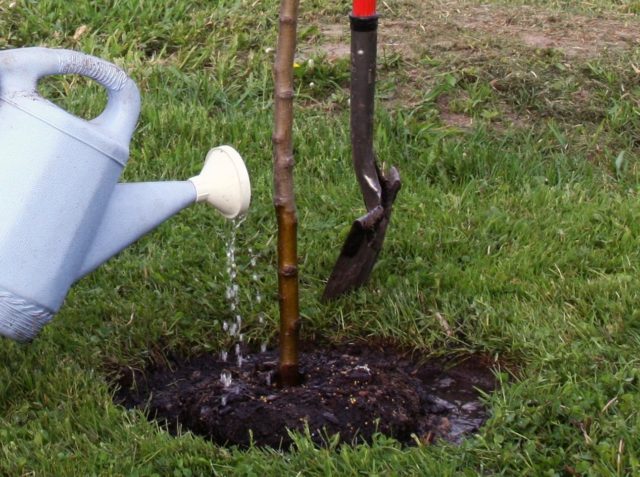
Watering a young tree is required
In the first year after planting, the seedling does not need additional feeding.The tree receives all the nutrients it needs from the soil used for planting. It is recommended to apply the first fertilizers from the second year of life, from the moment of depletion of the soil. The frequency and abundance of dressings should increase as the cherries enter the fruiting stage.
Pruning
The formation of the crown is one of the important activities for the care of cherries. Pruning old branches and removing dry ones promotes tree growth and increases yields. It is necessary to prune a young tree annually, in the spring, before bud break. The place of the cut must be treated with a garden pitch. On average, the crown formation process lasts 5 years.
The first tree pruning is carried out in the year of planting. The 6 strongest branches are left on the cherry, the rest are eliminated. It is important to regularly remove root shoots, infected and unproductive branches.
Preparing for winter
It is recommended to start the main pre-winter preparation at the end of October. The branches of the tree are pressed against the trunk and wrapped in straw, tops or burlap. You can protect the root system from winter frost with snow. For this, a small snowdrift is made around the trunk.
Young seedlings need to be more carefully insulated, since it is much more difficult for them to endure winter frosts. Therefore, in the first year after planting, in addition to the main shelter, the trunk circle is also mulched with peat or sawdust.
Diseases and pests
During the flowering period, Nord Star cherries are highly susceptible to infection with moniliosis. The threat especially increases during long and heavy rains. Fungal disease is provoked by the death of individual branches and generally weakens the tree.
As a preventive measure, trees should be regularly inspected for infected branches and leaves. In this case, the damaged parts of the tree are removed and treated with antibacterial drugs.
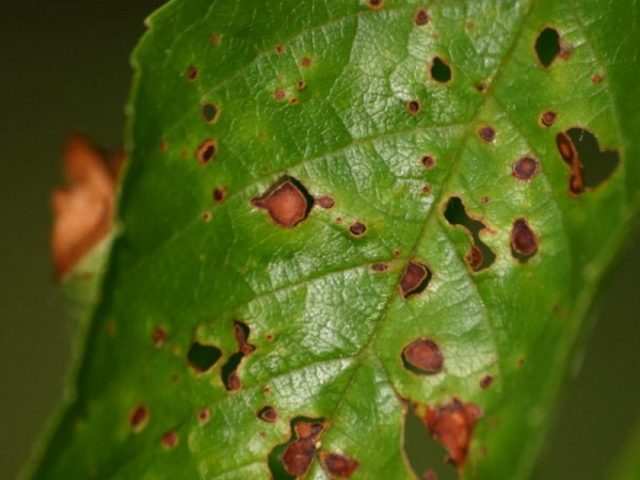
The appearance of spots on the leaves is the first sign of a tree disease
Conclusion
Cherry Nord Star is a variety that has long been chosen by orchards. It is distinguished by high productivity, undemanding care and good adaptability to unfavorable climatic conditions. Gardeners who have opted for this variety should familiarize themselves with the recommendations of specialists in order to get an annual stable harvest without unnecessary hassle.
